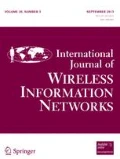Abstract
An energy-based primary signal detection framework is proposed to study the quality of detection (QoD) performance for cognitive radio sensor networks (CRSNs) under single cognitive sensor (CS) detection and multiple CS detection. We use hypothesis testing to first derive the exact solution and then the approximate solution (with less computational complexity) of the QoD metrics. Based on the approximate solution, we develop an adaptive QoD control scheme to maintain the QoD requirements. Numerical simulations are provided to validate the analysis. The proposed framework and analytic results are expected to be applied to different aspects (e.g., protocol design, network deployment) of CRSNs.





Similar content being viewed by others
References
S. Tang, Y. Zhang, L. Zhang, and R. Yu, “Spectrum-Efficient Wireless Sensor Networks,” Hindawi International Journal of Distributed Sensor Networks, Vol. 2015, Article ID 614680, 2015. (http://dx.doi.org/10.1155/2015/614680)
I. Howitt and J. A. Gutierrez, “IEEE 802.15.4 Low Rate - Wireless Personal Area Network Coexistence Issues,” in Proc. IEEE WCNC ‘03, pp. 1481-1486, March 2003.
S. Y. Shin, H. S. Park, S. Choi and W. H. Kwon, Packet error rate analysis of zigbee under WLAN and Bluetooth interferences, IEEE Trans. on Wireless Communications, Vol. 6, pp. 2825–2830, 2007.
J Mitola, Cognitive radio: an integrated agent architecture for software defined Radio, Ph.D. dissertation, Royal Institute of Technology, Stockholm, Sweden, 2000.
H. L. Van Trees, Detection, Estimation and Modulation Theory: Part I, Wiley-Interscience, 2001.
H. Urkowitz, Energy detection of unknown deterministic signals, Proceedings of IEEE, Vol. 55, pp. 523–531, 1967.
F. Digham, M.-S. Alouini and M. K. Simon, On the energy detection of unknown signals over fading channels, IEEE Trans. on Communications, Vol. 55, No. 1, pp. 21–24, 2007.
H. Sun, D. I. Laurenson, and C.-X. Wang, “Computationally Tractable Model of Energy Detection Performance over Slow Fading Channels,” IEEE Communications Letters, vol. 14, No. 10, pp. 924-926, Oct. 2010
S. Atapattu, C. Tellambura and H. Jiang, “Energy Detection Based Cooperative Spectrum Sensing in Cognitive Radio Networks,” IEEE Trans. on Wireless Communications, Vol. 10, No. 4, pp. 1232-1241, Apr. 2011.
M. Lopez-Benitez and F. Casadevall, “Signal Uncertainty in Spectrum Sensing for Cognitive Radio,” IEEE Trans. on Communications, Vol. 61, No. 4, pp. 1231-1241, April 2013.
A. Bagwari and G. S. Tomar, Adaptive double-threshold based energy detector for spectrum sensing in cognitive radio networks, International Journal of Electronics Letters, Vol. 1, No. 1, pp. 24–32, 2013.
D. M. Martínez and Á. G. Andrade, “Reducing the effects of the noise uncertainty in energy detectors for cognitive radio networks,” International Journal of Communication Systems, Dec., 2014. doi:10.1002/dac.2907.
N. Armi, B.A.W Chaeriah, and M. Arhad, “Performance Evaluation of Energy Detector in Cognitive Radio System,” Advanced Science Letters, Vol. 21, No. 11, pp. 3494-3496, Nov. 2015.
I. S. Gradshteyn and I. M. Ryzhik, “Table of Integrals, Series, and Products,” 7th ed., Academic Press, 2007.
M. Abdulsattar and Z. Hussein, Energy Detector with Baseband Sampling for Cognitive Radio: Real-Time Implementation, Wireless Engineering and Technology, Vol. 3, No. 4, pp. 229–239, 2012.
P. K. Varshney, Distributed detection and data fusion, Springer-VerlagNew York, 1997.
A. Ghasemi and E. Sousa, “Collaborative spectrum sensing for opportunistic access in fading environments,” in Proc. IEEE Symp. on New Frontiers in Dynamic Spectrum Access Networks (DySPAN), pp. 131–136, Nov. 2005.
Y.-C. Liang, Y. Zeng, C. Peh, and A. T. Hoang, “Sensing-throughput tradeoff for cognitive radio networks,” IEEE Trans. on Wireless Communications, vol. 7, pp. 1326–1337, Apr. 2008.
A. A. EI-Saleh, M. Ismail, and M. A. M. Ali, “Optimizing spectrum sensing parameters for local and cooperative cognitive radios,” in 11th International Conference on Advanced Communication Technology (ICACT 2009), (Phoenix Park, Korea), Feb. 2009.
Z. W. Birnbaum, J. D. Esary, and S. C. Saunders, “Multi-component systems and structures and their reliability,” Technometrics, vol. 1, pp. 55–77, Feb. 1961.
Author information
Authors and Affiliations
Corresponding author
Rights and permissions
About this article
Cite this article
Tang, S., Trautman, A. & Nguyen, H. On Energy-Based Quality of Detection (QoD) for Cognitive Radio Sensor Networks. Int J Wireless Inf Networks 23, 214–221 (2016). https://doi.org/10.1007/s10776-016-0313-4
Received:
Accepted:
Published:
Issue Date:
DOI: https://doi.org/10.1007/s10776-016-0313-4




